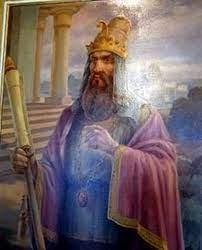Historical Details Related to
First Kings 5:1 to 9:9

Virtually all of the historical details noted in First Kings Chapters 3 and 4 apply here also; but in addition, the reader will observe the importance of Tyre in these accounts. Chapter 5 says that Hiram king of Tyre had enjoyed good relations with David and thus sent envoys to Solomon, obviously hoping to continue the alliance (First Kings 5:1). Solomon sent back a reply that stated his plans to build a Temple for ADONAI, and asked for cedar, some laborers, and suggested payment for those favors (First Kings 5:3-6). Who was Hiram, and why should he help Solomon?
Hiram ruled Tyre, the capital of Phoenicia, for over thirty years, from David’s old age until he and Solomon were veteran kings.110 Tyre had a mainland base but also occupied an offshore island, which kept it invulnerable to siege warfare up to the time of Alexander the Great in 332 BC (see the commentary on Isaiah, to see link click Eq – The Timeline for Tyre). From its Mediterranean port, Tyre was able to establish an impressive shipping fleet. Isra’el had aided Tyre’s sailing efforts by defeating the Philistines, the other regional power traditionally involved in sea trade. Therefore, an Isra’el-Tyre alliance was a natural, mutually beneficial result of Isra’el’s newly won prominence. Together, the two countries could create a monopoly by exploiting Isra’el’s control of the land and Tyre’s expertise in shipping.
Besides those natural common interests, Solomon and Hiram were both aggressive young kings. Both used the historical situation to their advantage. They both expanded their capitals and built central worship centers. Both desired to make their nation wealthy without military conquest, and both suffered when Egypt reasserted its power late in their reigns.
One other historical fact deserves mention. Isra’el’s Temple was similar to what many other nations were attempting before and during this time period. As already stated, Hiram himself built worship centers. He set up a golden pillar in the sanctuary of Ba’al Shamen, and built new temples to Melqart and Astarte. Sumeria, Assyria, Babylon, and the Canaanites also constructed temples. So this was common practice during that historical period.
Besides attesting to the accuracy of the biblical accounts, this observation reminds us of the literary nature of First and Second Kings. Isra’el is not portrayed as doing odd, astounding things. Rather, their activities, which appear like those of other nations, are significant because of how they displayed (or fail to display) Isra’el’s faith in ADONAI. They also reflect God acting in history through a chosen people. Therefore, the uniqueness of the events lies in the inherent meaning that emerges from a people responding faithfully to the one true God, the God of Abraham, Isaac, and Jacob, who alone deserves worship.111



Leave A Comment